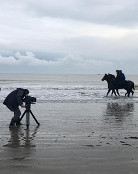Donn's Articles » Weight for age
Weight for age
Workforce’s win in the Qatar Prix de l’Arc de Triomphe on Sunday further enhanced the exceptional record that three-year-olds enjoy in the race. The Classic generation has now won seven of the last eight and 14 of the last 17 renewals of the Arc, quite a remarkable statistic for a race that is billed as the all-aged middle-distance championship of Europe.
Sakhee, Marienbard and Dylan Thomas are the only older horses to win the Arc since Urban Sea won it as a four-year-old in 1993, and it is not as if the Classic generation have been proportionately over-represented in recent times. There were eight three-year-olds in Sunday’s race, they made up less than half the field, yet they filled three of the first four places. In last year’s renewal, there were seven three-year-olds in a field of 19, including two multi-hundred to one pacemakers, yet they still managed to finish first and third. When Zarkava won it in 2008, she was one of just five three-year-olds in a field of 15.
The proportion of three-year-old representation in the Arc de Triomphe has been largely consistent over the last 20 years. When Carnegie won the race in 1994, at the beginning of this phenomenon that has now materialised into a trend, he was one of just seven three-year-olds in a field of 20. Lammtarra was one of six in a field of 16, as was Peintre Celebre, while Montjeu was one of six in a field of 14. And while there were 10 three-year-olds in Sagamix’s Arc in 1998, they made their numerical advantage tell by filling the first four places.
When there appears to be a dominant trend in a competitive event, it is legitimate to seek a rationale. Perhaps the fact that there is still a propensity for the very best three-year-olds to be retired from racing at the end of their three-year-old season has deprived the older horses’ team, such as it is, of some of its leading players. Sure enough, the last three three-year-old winners of the Arc, Sea The Stars, Zarkava and Rail Link, all left their respective racing careers behind them when they left Longchamp on the day that they won the Arc.
However, that may be too simplistic an explanation. Of the 14 three-year-old winners of the Arc in the last 17 years, five returned the following season to try to defend the title, and all five failed. Carnegie could finish no better than sixth behind Lammtarra, Helissio also finished sixth behind Peintre Celebre, Montjeu finished fourth behind Sinndar, Bago finished third behind Hurricane Run, and Hurricane Run could himself finish no better than third behind Rail Link when he returned to Longchamp as a four-year-old in 2006.
Another possible explanation is that it is just too difficult for a three-year-old to go back the following year and win it again. Maybe it is like the Cheltenham Gold Cup in that respect, that horses remember the depths to which they had to dig in order to win the race, and are not inclined to dig so deep again 12 months later. Alleged in 1977/78 is the last three-year-old winner to win the Arc again as a four-year-old, and before him you have to go back to Ribot in the mid-1950s. The 1984 winner Sagace was first past the post again in 1985 before he was demoted and the race awarded to Rainbow Quest, but he was a four-year-old when he first won it.
Or perhaps it is a weight issue. The fact that three-year-olds receive 8lb from their elders in the Arc is a fact that is not generally the subject of much debate. That is how it is, that is how it always was, Admiral Rous’s weight-for-age scale decrees as much. However, there is a chance that the weight allowance confers an unfair advantage on the youngsters. The record of three-year-old winners returning as four-year-olds, when they are conceding weight to their youngers instead of receiving weight from their elders, certainly suggests as much.
Also, in a true all-aged championship, should all contenders not compete on a level playing field? Rory McIlroy doesn’t play off a handicap of four because he is 21. And if a youngster in receipt of a weight concession does happen to prevail, can he truly be proclaimed the champion?
One other point worth considering. Admiral Rous developed his weight-for-age scale in the 1860s. Thoroughbred breeding and training methodology has moved on just a little since then. There are not many things in the modern world that have existed, with just minor alterations, since the 1860s. We are coming up to the 150th anniversay of the admiral’s ground-breaking work – perhaps it is time to have a look at it again.
© The Racing Post, 5th October 2010


 Follow Donn
Follow Donn